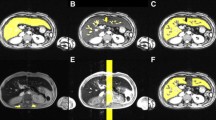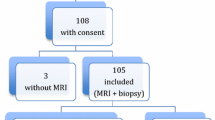Abstract
Objectives
To evaluate the performance and limitations of the R2* and signal intensity ratio (SIR) methods for quantifying liver iron concentration (LIC) at 3 T.
Methods
A total of 105 patients who underwent a liver biopsy with biochemical LIC (LICb) were included prospectively. All patients underwent a 3-T MRI scan with a breath-hold multiple-echo gradient-echo sequence (mGRE). LIC calculated by 3-T SIR algorithm (LICSIR) and by R2* (LICR2*) were correlated with LICb. Sensitivity and specificity were calculated. The comparison of methods was analysed for successive classes.
Results
LICb was strongly correlated with R2* (r = 0.95, p < 0.001) and LICSIR (r = 0.92, p < 0.001). In comparison to LICb, LICR2* and LICSIR detect liver iron overload with a sensitivity/specificity of 0.96/0.93 and 0.92/0.95, respectively, and a bias ± SD of 7.6 ± 73.4 and 14.8 ± 37.6 μmol/g, respectively. LICR2* presented the lowest differences for patients with LICb values under 130 μmol/g. Above this value, LICSIR has the lowest differences.
Conclusions
At 3 T, R2* provides precise LIC quantification for lower overload but the SIR method is recommended to overcome R2* limitations in higher overload. Our software, available at www.mrquantif.org, uses both methods jointly and selects the best one.
Key points
• Liver iron can be accurately quantified by MRI at 3 T
• At 3 T, R2* provides precise quantification of slight liver iron overload
• At 3 T, SIR method is recommended in case of high iron overload
• Slight liver iron overload present in metabolic syndrome can be depicted
• Treatment can be monitored with great confidence




Similar content being viewed by others
Abbreviations
- AUC:
-
area under the curve
- BMI:
-
body mass index
- DIOS:
-
dysmetabolic iron overload syndrome
- LIC:
-
liver iron concentration
- LICb :
-
LIC assessed by biopsy using biochemical analysis
- LICR2* :
-
LIC calculated by T2* conversion
- LICSIR :
-
LIC calculated by SIR method
- mGRE:
-
multiple-echo gradient-echo sequence
- MRI:
-
magnetic resonance imaging
- NASH:
-
non-alcoholic steatohepatitis
- SIR:
-
signal intensity ratio
References
Blachier M, Leleu H, Peck-Radosavljevic M et al (2013) The burden of liver disease in Europe: a review of available epidemiological data. J Hepatol 58:593–608
Moukhadder HM, Halawi R, Cappellini MD, Taher AT (2017) Hepatocellular carcinoma as an emerging morbidity in the thalassemia syndromes: a comprehensive review. Cancer 123:751–758
Deugnier Y, Turlin B (2011) Pathology of hepatic iron overload. Semin Liver Dis 31:260–271
Hatfield MK, Beres RA, Sane SS, Zaleski GX (2008) Percutaneous imaging-guided solid organ core needle biopsy: coaxial versus noncoaxial method. AJR Am J Roentgenol 190:413–417
Wood JC, Zhang P, Rienhoff H et al (2015) Liver MRI is more precise than liver biopsy for assessing total body iron balance: a comparison of MRI relaxometry with simulated liver biopsy results. Magn Reson Imaging 33:761–767
Anderson LJ, Holden S, Davis B et al (2001) Cardiovascular T2-star (T2*) magnetic resonance for the early diagnosis of myocardial iron overload. Eur Heart J 22:2171–2179
St Pierre TG, Clark PR, Chua-anusorn W et al (2005) Noninvasive measurement and imaging of liver iron concentrations using proton magnetic resonance. Blood 105:855–861
Wood JC, Enriquez C, Ghugre N et al (2005) MRI R2 and R2* mapping accurately estimates hepatic iron concentration in transfusion-dependent thalassemia and sickle cell disease patients. Blood 106:1460–1465
Hankins JS, McCarville MB, Loeffler RB et al (2009) R2* magnetic resonance imaging of the liver in patients with iron overload. Blood 113:4853–4855
Garbowski MW, Carpenter J-P, Smith G et al (2014) Biopsy-based calibration of T2* magnetic resonance for estimation of liver iron concentration and comparison with R2 Ferriscan. J Cardiovasc Magn Reson 16:40
Henninger B, Zoller H, Rauch S et al (2015) R2* relaxometry for the quantification of hepatic iron overload: biopsy-based calibration and comparison with the literature. Rofo 187:472–479
Gandon Y, Olivié D, Guyader D et al (2004) Non-invasive assessment of hepatic iron stores by MRI. Lancet 363:357–362
Alústiza JM, Artetxe J, Castiella A et al (2004) MR quantification of hepatic iron concentration. Radiology 230:479–484
Ernst O, Rose C, Sergent G, L’Herminé C (1999) Hepatic iron overload: quantification with MR imaging at 1.5 T. AJR Am J Roentgenol 172:1141–1142
Brissot P, Troadec M-B, Bardou-Jacquet E et al (2008) Current approach to hemochromatosis. Blood Rev 22:195–210
Meloni A, Positano V, Keilberg P et al (2012) Feasibility, reproducibility, and reliability for the T*2 iron evaluation at 3 T in comparison with 1.5 T. Magn Reson Med 68:543–551
Paisant A, Boulic A, Bardou-Jacquet E et al (2017) Assessment of liver iron overload by 3 T MRI. Abdom Radiol N Y 42:1713–1720
Rockey DC, Caldwell SH, Goodman ZD et al (2009) Liver biopsy. Hepatology 49:1017–1044
Bacon BR, Adams PC, Kowdley KV et al (2011) Diagnosis and management of hemochromatosis: 2011 practice guideline by the American Association for the Study of Liver Diseases. Hepatology 54:328–343
Barry M, Sherlock S (1971) Measurement of liver-iron concentration in needle-biopsy specimens. Lancet 1:100–103
Storey P, Thompson AA, Carqueville CL et al (2007) R2* imaging of transfusional iron burden at 3T and comparison with 1.5T. J Magn Reson Imaging JMRI 25:540–547
Anwar M, Wood J, Manwani D et al (2013) Hepatic iron quantification on 3 Tesla (3 T) magnetic resonance (MR): technical challenges and solutions. Radiol Res Pract 2013:628150
Rose C, Vandevenne P, Bourgeois E et al (2006) Liver iron content assessment by routine and simple magnetic resonance imaging procedure in highly transfused patients. Eur J Haematol 77:145–149
Krafft AJ, Loeffler RB, Song R et al (2017) Quantitative ultrashort echo time imaging for assessment of massive iron overload at 1.5 and 3 Tesla. Magn Reson Med. https://doi.org/10.1002/mrm.26592
Acknowledgements
We received support from the national clinical research program for public hospitals of France. Thanks to Tracey Westcott for the language help. Thanks to all the MRI team of University Hospital of Rennes.
Funding
This study has received funding by the French national research program “Programme Hospitalier de Recherche Clinique (PHRC)”.
Author information
Authors and Affiliations
Corresponding author
Ethics declarations
Guarantor
The scientific guarantor of this publication is Prof Yves Gandon
Conflict of interest
The authors of this manuscript declare no relationships with any companies whose products or services may be related to the subject matter of the article.
Statistics and biometry
One of the authors (MJ) is a senior biostatistician and has significant statistical expertise.
Informed consent
Written informed consent was obtained from all subjects (patients) in this study.
Ethical approval
The study protocol (Clinical trial NCT00401336) was approved by the local institutional review board (ref. 05/17-544).
Study subjects or cohorts overlap
This series of patients have been previously used to define a liver-to-muscle signal intensity ratio (SIR) algorithm from five different monoecho sequences. Here we report the R2* results calculated from a multiecho sequence. We also calculated SIR results from this unique sequence using the previously reported algorithm based on monoecho sequences.
Methodology
• prospective
• diagnostic or prognostic study
• performed at one institution
Rights and permissions
About this article
Cite this article
d’Assignies, G., Paisant, A., Bardou-Jacquet, E. et al. Non-invasive measurement of liver iron concentration using 3-Tesla magnetic resonance imaging: validation against biopsy. Eur Radiol 28, 2022–2030 (2018). https://doi.org/10.1007/s00330-017-5106-3
Received:
Revised:
Accepted:
Published:
Issue Date:
DOI: https://doi.org/10.1007/s00330-017-5106-3




